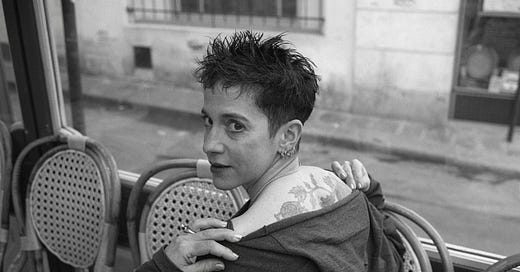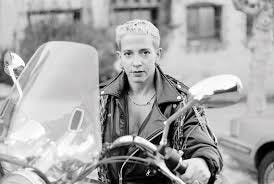I feel like I should love Kathy Acker. She was a take no prisoners, no fucks given, always innovating radical writer. I should at least praise her for pioneering a version of cut-and-paste that is more akin to sampling than the unintelligible word salads of William S. Burroughs. The fact that I use a similar technique when writing my stories (thank you to whomever left the World Literature Textbook in my apartment) should be enough to earn my unrelenting praise.
Sadly, I don't care for her work. I find it confusing and pretentious. I also read her too late to enjoy her brand of radical attack dog writing with its daddy obsessions and exhausting depictions of misogyny. Perhaps, I'm being sexist since I accept Acker's worst habits in other male writers; still, I can admire Acker for her audacity, even if I can't love her work.
As for “A Young Girl,” I don't know how I feel. My first professional sale came with a note from the editor saying that at first he liked it, then he hated it, then he really loved it. I don't think he ever came to love “Bop Kabala and Communist Jazz.” He simply acknowledged that it messed with his head too much to reject. I feel the same way about “A Young Girl.” I admire. I like it. I don't love it.
The Ending
The story ends with the heroine's father trying to burn her up in a car for an art project. He continually states that he loves art and her, but to really make great art, he must destroy her. The ending feels Biblical, but instead of G-d compelling Abraham to sacrifice Isaac, artistic standards compels the father. The mayor sets up the car fire murder, but once the father knows what's happening, he approves.
Happily, she doesn't die. The homeless people, who are being used as props, rescue her. They also judge both the mayor who set up this human sacrifice and the father who signed off on it. The homeless people are messed up and dirty. Some are crazy. Even they wonder what the fuck is wrong with a man who would burn up his daughter.
Of course, the ending is not entirely moral outrage. She has to convince them that she's not a hardened criminal. The bag ladies ask her what her father did to her and she has to imply molestation to get them to attack the mayor and the father.
Afterwards, the city debates the merits of the “artwork” with the public seeming to let the mayor off the hook. Father kills himself, but father was headed in that direction throughout the story. Then Kathy Acker ends it with a paragraph about pirates.
Without the pirates, I would have loved the ending. The pirates dilute it.
The Pirate Interludes
Acker used cut and paste techniques. She'd grab material from other works and use it in her books. In Great Expectations and Don Quixote, she used the classic novels as basis for her meditations on art and sexism, tearing into them and rearranging as she went along. She added literary theory and autobiography passages.
This story does not lean so heavily into the cut-and-paste, but it intersperses the father and daughter and mayor material with pirate stuff. It just keeps coming up, but it's not taking over the story. Unfortunately, the pirates are more irritating than interesting. They don't add to the story. There's really no point to talking about pirates founding New Amsterdam except to inject a little life into a rather lifeless mediation on urban blight. Without the pirates, the story is just about a girl that has to deal with her father and the mayor hating each other. With the pirates, there's random noise that never quite coheres into an actual narrative. That's most likely the point, but it still doesn't work. The pirates remind me why I find Acker more irritating than compelling.
Weird Nostalgia
This story takes place in a crime ridden New York where artists are being used to gentrify neighborhoods. The rents are cheap. The artists move in. The neighborhood becomes an artist haven even with junkies wandering around. More people want to live there. The landlords get greedy because they are always greedy. The artists get priced out unless they make it big.
The protagonist's father is one of the artists who managed to make it. He pleased the mayor. The mayor remains nameless but since it's the mayor who encouraged gentrification and was most likely gay, she's referring to Ed Koch. Of course, this is a fictional New York taking place in an alternative universe so it could be another gay mayor who fucked up the city in order to help his real estate friends buy buildings for cheap.
Tales of New York City in the 1970s and 1980s have become nostalgia bait. At the time, New York was a hell hole with babies rotting in the gutters and welfare families stuck in the backrooms of hotels because there wasn't enough housing. AIDS and crime was killing off the residents. The city was broke.
Yet, now we watch The Warriors for fun and Lin Manuel Miranda made an album out of it (hopefully coming to Broadway) and almost every documentary on New City at the time makes it sound like the place was magic. You could get an apartment for cheap. You could carry your Samurai sword on the subway. In fact, you needed to carry your Samurai sword on the subway. We know that this nostalgia is bullshit, but it's hard to shake.
Personally, I blame Rent.
So now Kathy Acker's tale of urban decay, terrible mayors, gentrification and an exploding homeless population feels like a warm tale of a bygone era. Definitely not Acker's purpose, but in post-modernism, the author is just another critic.
Overall, this story has the Kathy Acker tropes, a bad relationship with a terrible father, feminist rage, cut-and-paste interludes and the ways that society conspires to destroy women. It's powerful stuff and I'd definitely recommend it to anyone that wants an easy start to reading Acker. I don't love it, but I don't hate it either.
If you like me, please consider contributing to my Gofundme, getting a paid subscription or hiring me to edit your resume (omanlieder@yahoo.com)
Here’s an article on Kathy Acker’s Empire of the Senseless.
If you’d like to buy her version of Don Quixote, here it is.
Finally, I wrote Sugarplum Zombie Motherfuckers, so you can buy that too.






I read Acker and wrote an article about her and skin art for Tattoo magazine back when. She’s everything you say, pro and con, but also I liked the relentless hammering at the doors of meaning. Yeah.
But as for the East Village scene, I lived there from 1979 to 1995. And yeah, it was dirty, filthy and dangerous. It was also magical in ways I won’t bore you with, but suffice to say: I was never bored.